Freaky holiday films have been a longtime passion of mine. Such fare was the subject of a well-received essay I wrote back in 2003, an essay that nearly two decades later seems a bit limited in its scope. At issue is the fact that it (like quite a few other such rankings not written by me) is comprised largely of American-made offerings, despite the fact that many of the wildest Christmas-themed films hail from outside the United States. Here, then, is a much-needed addendum to my previous essay, with an overview of weird holiday-themed films emerging from around the world.
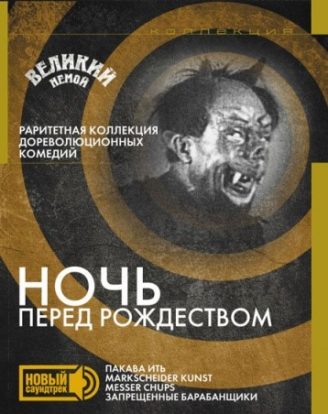 I’ll begin in 1913. It was then that the 41 minute CHRISTMAS EVE (NOCH PERED ROZHDESTVOM) premiered in Russia, it being the first attempt at bringing Nikolai Gogol’s 1831 tale THE NIGHT BEFORE CHRISTMAS to the screen. The story involves the devil, garbed in what looks a monkey costume, stealing the moon and disrupting the festivities of a peasant family on Christmas Eve. What’s ultimately most striking about this slight film are the elaborate special effects of a type its director Wladyslaw Starewicz helped pioneer, particularly the sight of the devil shrinking down to insect size and being put in the pocket of a normal-sized man, an effect captured in a single shot.
I’ll begin in 1913. It was then that the 41 minute CHRISTMAS EVE (NOCH PERED ROZHDESTVOM) premiered in Russia, it being the first attempt at bringing Nikolai Gogol’s 1831 tale THE NIGHT BEFORE CHRISTMAS to the screen. The story involves the devil, garbed in what looks a monkey costume, stealing the moon and disrupting the festivities of a peasant family on Christmas Eve. What’s ultimately most striking about this slight film are the elaborate special effects of a type its director Wladyslaw Starewicz helped pioneer, particularly the sight of the devil shrinking down to insect size and being put in the pocket of a normal-sized man, an effect captured in a single shot.
Gogol’s text was utilized again in the 1951 animated mini-feature NOCH PAERED ROZHDESTVOM, from the Soviet animation studio Soyuzmultfilm, and directors/animators Valentina and Zinaida Brumberg. The so-called “grandmothers of the Russian animation,” the Brumberg sisters were masters of old school cell animation, and turned out an impressively visualized fantasy that renders the story in a cogent and orderly manner (albeit one that’s over-reliant on voice-over narration).
Gogol’s tale was adapted yet again, this time in live action format, in 1961’s EVENINGS ON A FARM NEAR DIKANKA (VECHERA NA KHUTORE BLIZ) by Aleksandr Rou, one of Russia’s masters of cinematic fantasy. Here Rou evidently went out of his way to make the proceedings as broad and cartoony as possible. There are some impressive practical effects that recall Rou’s more accomplished films, such as a self-shoveling snow pile and the devil’s multiple flights across the sky, but they’re mitigated by the patently stage-bound scenery, which comes complete with a painted “night sky.”
Far more interesting, in my view, is MASHA AND VITYA’S ADVENTURES ON NEW YEAR’S EVE (PRO VITYU, PRO MASHU I 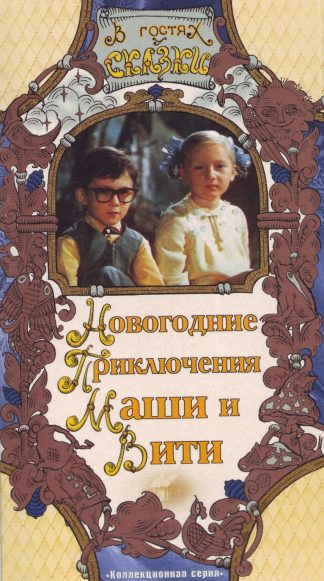 MORSKUYU PEKHOTU), a Soviet children’s fantasy hailing from 1974. Lacking the imposing source material of the previous films, this one is more modest in conception and execution, but every bit as colorful. Featured are a young boy and girl whisked through the branches of a magic New Year’s Tree (in the Soviet Union the New Year was celebrated in place of Christmas) into a fairy tale forest inhabited by a tin man, a fairy princess, a talking stove, a sentient peach tree and a scary witch looking to do the kids in. In the same category is the twenty minute 1983 Claymation wonder LAST YEAR’S SNOW WAS FALLING (PADAL PROSHLOGODNIY SNEG), a folklore inspired reverie about an eccentric man’s attempts at finding a Christmas/New Year’s Tree, an odyssey that sees him daydreaming of mutating into various objects, ruling Russia and moving into a walking house, visualized via insanely inventive Claymation.
MORSKUYU PEKHOTU), a Soviet children’s fantasy hailing from 1974. Lacking the imposing source material of the previous films, this one is more modest in conception and execution, but every bit as colorful. Featured are a young boy and girl whisked through the branches of a magic New Year’s Tree (in the Soviet Union the New Year was celebrated in place of Christmas) into a fairy tale forest inhabited by a tin man, a fairy princess, a talking stove, a sentient peach tree and a scary witch looking to do the kids in. In the same category is the twenty minute 1983 Claymation wonder LAST YEAR’S SNOW WAS FALLING (PADAL PROSHLOGODNIY SNEG), a folklore inspired reverie about an eccentric man’s attempts at finding a Christmas/New Year’s Tree, an odyssey that sees him daydreaming of mutating into various objects, ruling Russia and moving into a walking house, visualized via insanely inventive Claymation.
Pivoting rather dramatically: LETTERS FROM A DEAD MAN (PISMA MYORTVOGO CHELOVEKA), from 1986, is certainly the most depressing “Christmas” movie of all time. A relentlessly bleak and unforgiving depiction of life in the wake of a nuclear war, it’s one of the key entries in the 1980s nuke movie cycle, and one of the most shattering Soviet films of the decade. It’s of interest here because a climactic scene takes place on Christmas, with a character reminiscing about how the holiday was in the pre-nuke (and pre-covid) era.
Before leaving Russia I’ll have to mention a most interesting animated rendering of THE NUTCRACKER (SHCHELKUNCHIK) from 1973. Taking account of both the 1816 story “The Nutcracker and the Mouse King” by E.T.A. Hoffmann and the 1892 ballet by Tchaikovsky, it’s a dazzling 25 minute spectacle that does the material justice. You probably know the story, in which a nutcracker doll leads a young girl on Christmas/New Year’s into an enchanted land threatened by a multi-headed mouse king. This film is distinguished by highly stylized animation, and the fact that it plays entirely without dialogue, with the music of Tchaikovsky’s immortal ballet (and snatches from “Swan Lake” and “Sleeping Beauty”) providing the soundtrack. An English language redub exists with vocals by Shirley MacLaine and Hans Conreid, but the film deserves to be viewed in its original and intended format.
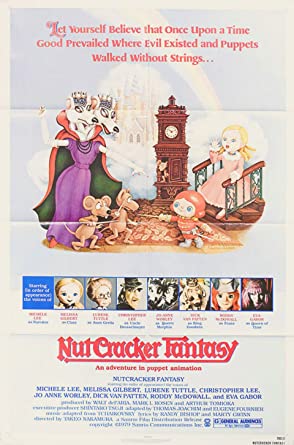 While on the subject of THE NUTCRACKER, let’s turn our attention to Japan. Christmas in Japan? Yes, there is such a thing, although it is, in a country whose population is a reported 70 percent Shinto and 67 percent Buddhist (and a whopping one percent Christian), somewhat rare. Nonetheless, it is possible to find a (very) few Christmas themed Japanese films, including Nagisa Oshima’s 1983 British-Japanese co-production MERRY CHRISTMAS MR. LAWRENCE (a film I’ve always found vastly overrated) and, more appropriate to this essay, 1979’s NUTCRACKER FANTASY (KURUMI-WARI NINGYOU). This stop motion curio is very much in the mold of the classic Rankin-Bass Christmas specials. The major difference between those films and NUTCRACKER FANTASY is that the latter is deeply, thoroughly and profoundly weird, with the dream motif of THE NUTCRACKER’s underlying narrative played up greatly. What’s played down is the Christmas angle, although it’s evident nonetheless in the enchanted winter setting. The animation isn’t up to Rankin-Bass standards, but director Takeo Nakamura does succeed in creating an authentically dreamlike and poetic fantasia.
While on the subject of THE NUTCRACKER, let’s turn our attention to Japan. Christmas in Japan? Yes, there is such a thing, although it is, in a country whose population is a reported 70 percent Shinto and 67 percent Buddhist (and a whopping one percent Christian), somewhat rare. Nonetheless, it is possible to find a (very) few Christmas themed Japanese films, including Nagisa Oshima’s 1983 British-Japanese co-production MERRY CHRISTMAS MR. LAWRENCE (a film I’ve always found vastly overrated) and, more appropriate to this essay, 1979’s NUTCRACKER FANTASY (KURUMI-WARI NINGYOU). This stop motion curio is very much in the mold of the classic Rankin-Bass Christmas specials. The major difference between those films and NUTCRACKER FANTASY is that the latter is deeply, thoroughly and profoundly weird, with the dream motif of THE NUTCRACKER’s underlying narrative played up greatly. What’s played down is the Christmas angle, although it’s evident nonetheless in the enchanted winter setting. The animation isn’t up to Rankin-Bass standards, but director Takeo Nakamura does succeed in creating an authentically dreamlike and poetic fantasia.
Japan gave us another take on THE NUTCRACKER in 1995. It is, alas, a bland and uninspired cartoon marked by lazy, cut-rate animation that pictures the title personage as, essentially, a small man with a wide smile (although the rodent queen here is a striking creation with seven heads). Gone is the surreal charge of the earlier film, although this one does contain the expected musical segues—and a more overtly Holiday themed narrative.
India is another country that isn’t known for its Yuletide traditions, although a reported 26 percent of its population identifies as Christian—which, given India’s enormous population, translates to over 25 million Indians who celebrate Christmas. The Bollywood thriller HIDE & SEEK (2010) is among the few Indian films that exploit the holiday, in the form of a thinly disguised SAW wannabe set in a nighttime shopping mall. There two feuding brothers awaken, together with several childhood friends, all of whom have been abducted by an unknown someone wearing a Santa Claus—or, as he’s known in the Hindu world, Christmas Baba—mask, who enlists them in some deadly games. Lots of twists are in store, but the film suffers from an overly antic, melodramatic treatment that’s overwrought even by traditional Bollywood standards, and a narrative that grows increasingly implausible.
South Korea is an Asian nation that, like India, has a healthy Christian presence (roughly 25-30 percent of the population identifies as such), 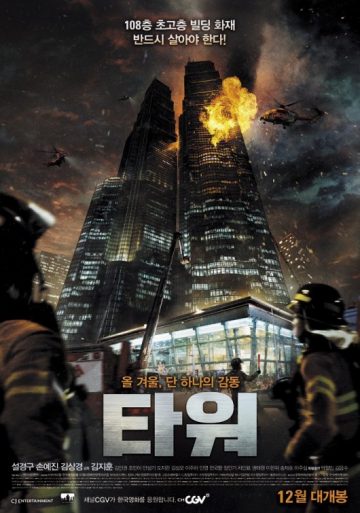 so Christmas is celebrated there, and is indeed a national holiday. It was the source for the THE TOWER (TA-WEO; 2012), an actioner that feels like precisely the imitation Hollyweird product it is—think THE TOWERING INFERNO crossed with DIE HARD. The opening half is pretty dull, but once all the characters are ensconced on Christmas Eve in the high rise where the film takes place, and two helicopters set off a catastrophic fire after crashing into an upper level, things pick up.
so Christmas is celebrated there, and is indeed a national holiday. It was the source for the THE TOWER (TA-WEO; 2012), an actioner that feels like precisely the imitation Hollyweird product it is—think THE TOWERING INFERNO crossed with DIE HARD. The opening half is pretty dull, but once all the characters are ensconced on Christmas Eve in the high rise where the film takes place, and two helicopters set off a catastrophic fire after crashing into an upper level, things pick up.
The Philippines is an Asian country that unabashedly embraces Christmas. It even has its own holiday tradition in the form of Simbang Gabi (Night Mass), consisting of nine days of masses leading up to Christmas Day. This, however, hasn’t translated into a robust Christmas movie presence; as one Filipino blogger recently complained, “the Philippines, a country that loves celebrating Christmas, cannot seem to muster up one memorable film about the holiday.”
Certainly the first portion of the horror anthology film SHAKE, RATTLE AND ROLL 9, the 38 minute “Christmas Tree,” wouldn’t make anyone’s list of “good” Filipino Christmas movies. It contains a Xmas tree that comes to life as a Swamp Thing-looking critter that chases a family around a house; those it catches it eats, conveyed via special effects whose quality is about what you might expect. DARKEST NIGHT, from 2012, isn’t much better. It’s a found footage thriller, a trope this film utilizes to the fullest, down to the opening disclaimer about how the footage was discovered in the ruins of a house whose inhabitants all mysteriously disappeared. We see a Christmas family shindig at the house in question, marred by a power outage and supernatural forces that, as the found footage format dictates, go largely unseen, and camerawork that never stays still.
Moving into Continental Europe, we arrive at GOODBYE 20th CENTURY (ZBOGUM NA DVAESETIOT VEK; 1998), an unalloyed bit of sheer weirdness from Macedonia. The official synopsis dubs this head-scratcher “a film of a generation which has grown up and lives at the threshold of a war that neither begins nor ends…a visionary tale which condemns the decayed century to a very scary death.” It’s impressively lensed, at least, and there’s a rockin’ climactic shootout set to Sid Vicious’s “My Way,” spearheaded by a guy in Santa Claus get-up.
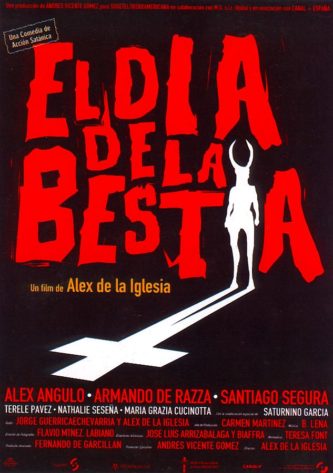 Hailing from Spain is a film that should be a cult mainstay in the US (as it is in much of the rest of the world), but missed its calling due to a famously botched American release. No matter: Alex de la Iglesia’s DAY OF THE BEAST (EL DIA DE LA BESTIA; 1995), about a priest looking to call up and take on Satan by committing as much evil as he possibly can on Christmas Eve, is still one of the most outrageous, twisted and darkly hilarious holiday movies in existence. The lunacy on display includes mime abuse, an accidental murder, department store actors getting machine gunned and a TV star informing his viewers that “Christmas is fucked!”
Hailing from Spain is a film that should be a cult mainstay in the US (as it is in much of the rest of the world), but missed its calling due to a famously botched American release. No matter: Alex de la Iglesia’s DAY OF THE BEAST (EL DIA DE LA BESTIA; 1995), about a priest looking to call up and take on Satan by committing as much evil as he possibly can on Christmas Eve, is still one of the most outrageous, twisted and darkly hilarious holiday movies in existence. The lunacy on display includes mime abuse, an accidental murder, department store actors getting machine gunned and a TV star informing his viewers that “Christmas is fucked!”
For a more sober-minded Spanish made atrocity, check out THE PATH (LA SENDA; 2012), a subjective-descent-into-madness account in the grand tradition of classics like REPULSION and THE TENANT. The skilled Gustavo Salmerón plays a schizophrenic man growing increasingly paranoid and disconcerted during a Christmas vacation in a forest with his wife and young son. Director Miguel Ángel Toledo complements Salmerón’s achievement with a spare and atmospheric treatment that makes use of something that’s become all-too rare in films nowadays: silence. It’s too bad the proceedings go south in the final half-hour, with hokey hallucinations and gore that seriously compromise the excellence of what came before.
The Netherlands got into the holiday horror act with SINT (or SAINT), which is short for Sinterklaas (as Saint Nicholas, the patron saint of children, is known in Dutch). This very silly 2010 horror movie take on the figure was written and directed by the veteran Dutch trashmeister Dick Maas, of classics like AMSTERDAMNED. SINT is hardly a classic, but it is a diverting enough time passer, with Sinterklaas transformed into an undead maniac who periodically turns up in Amsterdam on the 5th of December when the moon is full, together with his zombie army, to kill and/or maim anyone who happens to be in his path. Maas can’t be bothered with things like subtlety or nuance, much less logic or plausibility, but viewers in the mood for a fast moving anti-holiday gore fest could certainly do worse.
Norway was the source for RARE EXPORTS (2010), a horrific inversion of the Santa Claus—or, as he’s known in Europe, Father Christmas- –legend. This Father Christmas, however, isn’t the “Coca Cola Santa” we’ve come to know, but a cannibalistic demon that kills children who aren’t nice. It’s up to a plucky young boy to save the world from this monstrosity after the critter is unearthed in a remote drilling outpost at the North Pole…
–legend. This Father Christmas, however, isn’t the “Coca Cola Santa” we’ve come to know, but a cannibalistic demon that kills children who aren’t nice. It’s up to a plucky young boy to save the world from this monstrosity after the critter is unearthed in a remote drilling outpost at the North Pole…
The Norwegians also gave us CHRISTMAS CRUELTY! (2013), which is almost certainly the nastiest film on this list, and indeed one of the most extreme holiday films to emerge from any country. It’s a no-budgeter made by Magne Steinsvoll and Per-Ingvar Tomren, who sought to learn the basics of filmmaking by making things as difficult for themselves as humanly possible. To this end they created a film about a deranged Santa Claus wannabe (Tormod Lien) whose doings demand extremely elaborate and protracted gore effects, and a deliberately formless structure that features lengthy scenes of characters, played by an amateur cast, blathering and getting drunk. This makes for an effort that taken as an experiment is somewhat interesting, but which fails to satisfy as a movie.
Then there’s France, where “Joyeux Noël” (Merry Christmas) and “Père Noël” (Santa C.) assume roughly the same importance they do in the U.S. Christmas is a mainstay there, and tends to creep into French films whether they’re holiday themed or not. Note the opening of THE CITY OF LOST CHILDREN (LA CITE DES ENFANTS PERDUS; 1995), consisting of a horrific dream sequence featuring a child terrorized by a mutating Santa, and the stately slashers SATAN (SHEITAN; 2006) and INSIDE (A L’INTERIEUR; 2007). The latter films have much in common, being key entries in the New French Extremity movement that pivot on childbirth and a murderous psychopath—an overacting Vincent Cassell in the former and a just-right Beatrice Dalle in the latter—and take place at Christmas. Otherwise, though, the two films are assuredly not holiday themed, and quality-wise tend to diverge quite dramatically. This is to say that one of them is a veritable masterpiece of unfettered cinematic dementia and the other is SATAN.
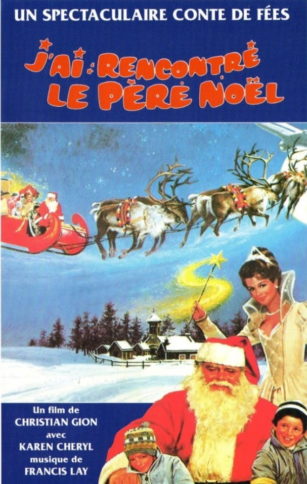 France was the source of the 1984 atrocity I BELIEVE IN SANTA CLAUS (J’AI RENCONTRE LE PERE NOEL). It’s certainly the only Christmas movie I know of that contains teleportation, a magic fairy, a dog-eating ogre, a killer alligator, monkeys, machine guns and two plucky kids who ask Santa to rescue their parents, who’ve been kidnapped by African mercenaries. Christian Gion is often referred to as the worst French director of all time, and this film, which is appalling, hilarious and downright creepy by turns, is often referred to as Gion’s “masterpiece.”
France was the source of the 1984 atrocity I BELIEVE IN SANTA CLAUS (J’AI RENCONTRE LE PERE NOEL). It’s certainly the only Christmas movie I know of that contains teleportation, a magic fairy, a dog-eating ogre, a killer alligator, monkeys, machine guns and two plucky kids who ask Santa to rescue their parents, who’ve been kidnapped by African mercenaries. Christian Gion is often referred to as the worst French director of all time, and this film, which is appalling, hilarious and downright creepy by turns, is often referred to as Gion’s “masterpiece.”
GAME OVER (36.15 CODE PERE NOEL; 1989) is at least competently made. Not “good,” mind you, but competent. The scary inverse of HOME ALONE, it’s a Gallic thriller that replaces that film’s mawkishness with darkness and perversity. Involving a kid taking on a freak dressed as Santa Claus, GAME OVER proves that French filmmakers can be every bit as exploitive and irresponsible as their Hollywood rivals.
Australia? It entered the freaky Christmas movie sweepstakes with FORTRESS (1985), a nail-biting adventure bearing a core of true horror. It starts one morning when four masked gunmen, led by a guy in a Father Christmas (Santa Claus) mask, kidnap teacher Rachel Ward and her students from a tiny outback schoolhouse, leading to action and suspense done the right way: fast and mean! Director Arch Nicholson, adapting a 1980 novel by Gabrielle Lord, doesn’t shy away from the nasty stuff, particularly in the final scenes, when Ward and the kids decide to stop running and fight their attackers. Even as we root for the Good Guys to get back at their adversaries, we’re not allowed to forget that these are little kids being forced into an extremely violent adult word (a point underlined by the Father Christmas masquerade). The profoundly disturbing final scene is one I’ve never forgotten.
Mexico got into the holiday spirit with 1959’s immortal SANTA CLAUS. A lavish and colorful film, it’s nobody’s idea of quality cinema, but it is quite bizarre, and features an irresistible premise involving Santa Claus, who here resides on a cloud high above the North Pole and utilizes mechanical reindeer, taking on none other than the devil himself. Need I say more?
The devil is once again referenced in PASTORELA (2011), a dark comedy that pivots on the pastorela (Mexican nativity play). About a policeman who every Christmas plays the devil in his town’s pastorela only to discover that he’s set to be replaced, it’s very culturally specific, and so not wholly comprehensible to non-Mexican viewers (a bit in which the police decide to arrest every devil in town seemed quite bizarre to this non-Mexican viewer, as based on what we’re shown people dressed as devils are apparently quite common in those parts). Still, the film as a whole is fun, with lines like “God bless you and fuck your mother!” that I’d say are pretty universal.
More Mexican madness can be found in the animated A MARTIAN CHRISTMAS, a 43 minute trifle that turned up on DVD in 2008. It 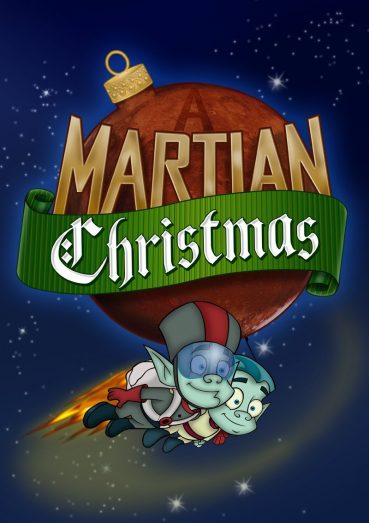 features a Martian boy with blue skin, pointy ears and coiled antennae stowing away on a space ship piloted by his father, who’s on a mission to destroy the Earth—at Christmastime. But along the way the kid meets Santa Claus, occasioning a change of heart about the Earth and the season. The pic is quite tacky, with lackluster computer animation, but it partakes of a Christmas-Martian combination that has proven oddly enduring.
features a Martian boy with blue skin, pointy ears and coiled antennae stowing away on a space ship piloted by his father, who’s on a mission to destroy the Earth—at Christmastime. But along the way the kid meets Santa Claus, occasioning a change of heart about the Earth and the season. The pic is quite tacky, with lackluster computer animation, but it partakes of a Christmas-Martian combination that has proven oddly enduring.
For proof check out the infamous American made no-budgeter SANTA CLAUS CONQUERS THE MARTIANS, and also 1971 French-Canadian jaw-dropper THE CHRISTMAS MARTIAN (LE MARTIEN DE NOEL). Here two kids enter a flying saucer and discover a Martian who can easily pass for a magically endowed human, leading to a great deal of dumb-assed slapstick and gooey sentimentality. The most interesting thing about the film is its depiction of the snowbound landscapes of Quebec, which are presented with the type of near-documentary immediacy that marks out the work of Quebecois auteurs like Claude Jutra and Francis Mankiewicz. Plus, some of the special effects, notably those depicting the protagonists rising up off the ground and walking on air, are downright startling (because it’s clear the actors really were being hoisted into the sky).
As if that weren’t enough, there was also A COSMIC CHRISTMAS (1977) from the Canadian cartoon outfit Nelvana. A thoroughly ludicrous TV special, it has a UFO disgorging a trio of aliens who closely resemble the three wise men of the gospels, to whom a young boy teaches the True Meaning of Christmas. There’s also a flying bicycle and a spaceship that flashes colors in the shape of a Christmas angel, all done up in Nelvana’s trademark funky-exaggerated animation style.
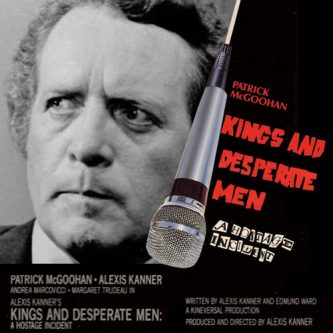 Canada, of course, has a hallowed tradition of holiday cinema. I know I’ll always remember the Canadian-made downer ONE MAGIC CHRISTMAS (1985), a thoroughly depressing IT’S A WONDERFUL LIFE wannabe concentrated on poverty, death and an angel played by Harry Dean Stanton(!). The earlier Christmas set, Montreal situated hostage thriller KINGS AND DESPERATE MEN (1981) is a diverting and at times fascinating exercise in arty excess by writer-director-star Alexis Kanner (of THE PRISONER) and co-star Patrick McGoohan. There’s also A CHRISTMAS HORROR STORY (2015), a four-part anthology film tied together by William Shatner as a small town DJ regaling his audience with holiday tunes. It’s an almost movie, with many promising elements—demonic creatures posing as human children, a zombie epidemic among Santa’s elves and the ever-popular specter of Krampus—that never quite reach their full potential.
Canada, of course, has a hallowed tradition of holiday cinema. I know I’ll always remember the Canadian-made downer ONE MAGIC CHRISTMAS (1985), a thoroughly depressing IT’S A WONDERFUL LIFE wannabe concentrated on poverty, death and an angel played by Harry Dean Stanton(!). The earlier Christmas set, Montreal situated hostage thriller KINGS AND DESPERATE MEN (1981) is a diverting and at times fascinating exercise in arty excess by writer-director-star Alexis Kanner (of THE PRISONER) and co-star Patrick McGoohan. There’s also A CHRISTMAS HORROR STORY (2015), a four-part anthology film tied together by William Shatner as a small town DJ regaling his audience with holiday tunes. It’s an almost movie, with many promising elements—demonic creatures posing as human children, a zombie epidemic among Santa’s elves and the ever-popular specter of Krampus—that never quite reach their full potential.
The same can be said for Christmas cinema as a whole, which all too often tends to substitute holiday tropes for quality. But there do exist LETTERS FROM A DEAD MAN, the 1973 NUTCRACKER, DAY OF THE BEAST and INSIDE, which prove that great cinema is possible within a Christmas framework, even if such movies tend to be few and far between.
